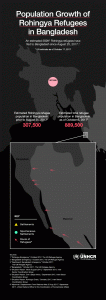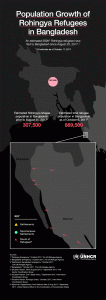
27 Oct This Map Shows The 500,000 Rohingya Refugees Displaced Since August
When her village in Myanmar was set on fire in early September, a woman named Juleka fled with a single bag and her 6-year-old daughter–two people among more than half a million refugees who have been forced from their homes since late August because they are members of the Rohingya minority being persecuted in a military-led campaign of violence. After walking for nine days, the mother and daughter reached the Kutupalong refugee camp in Bangladesh.

The latest flood of refugees follows hundreds of thousands of others who previously fled to Bangladesh, where the government now plans to build a single, massive refugee camp that can house 800,000 people. A new map from USA for UNHCR, the UN Refugee Agency, shows the growth of current makeshift settlements.
The Rohingya, who are predominantly Muslim, have faced a long history of discrimination in Myanmar, where the majority of people are Buddhist. After World War II–when the Rohingya sided with the British, and were promised land of their own in exchange from the colonial government–the land never materialized. When Myanmar became a country, the Rohingya weren’t given citizenship. The government crushed resistance movements. In the early 1990s, more than 250,000 refugees fled forced labor, religious persecution, and rape.
On August 25, after a Rohingya militant group attacked government security posts, the military intensified its own attacks, killing and raping villagers, and burning villages to the ground. In response, hundreds of thousands of people fled. The majority of the refugees are women and children; many others are elderly.
The UN Refugee Agency, along with others, is airlifting in tents, blankets, mosquito nets, and other supplies, installing latrines and wells, and supporting a government-led cholera vaccination program. But like other aid groups, it’s looking for support to send more supplies. “They have nothing and need everything,” says Jennifer Patterson, deputy executive director of USA for UNHCR.
Source: Fast Company




Sorry, the comment form is closed at this time.